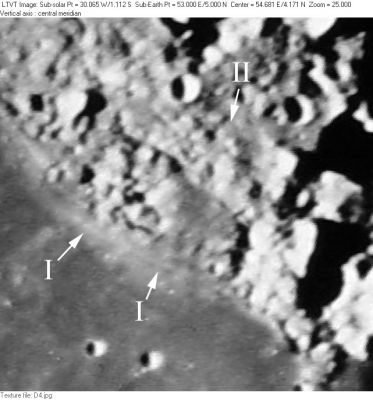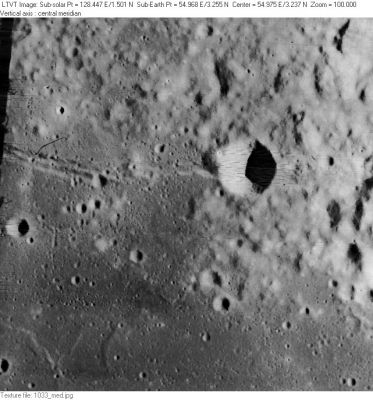Rimae Apollonius
Contents
[hide]Rimae Apollonius
|
Lat: 5.0°N, Long: 53.0°E, Length: 230 km, Depth: km, Rükl: 37 |


Left: Consolidated Lunar Atlas Plate D4 In this rectified Earth-based view, the two circular craters on the mare near the bottom are 5-km Smithson (left) and 7-km Taruntius O (right). Near top center is 10-km Abbot, and, to its right, the same size but less circular Bombelli. The Roman numerals indicate the positions of the Rima Apollonius I and II of LAC-62. Rille I (labeled Rima Apollonius on the later LM-62) is marginally visible. The identity of Rille II, which is said to run roughly parallel to this, slightly south of Abbot, is extremely unclear.
Right: LO-I-033M This Lunar Orbiter I medium resolution view shows a 4X enlargement of the eastern terminus of the old Rima Apollonius I in the area just above and to the right of the right-hand “I” label on the Consolidated Lunar Atlas photo (note the prominent 5.4-km diameter/950 m deep nameless crater common to both). Ideally the preceding frame, LO-I-032, would have shown the remainder of the rille, but the camera was canted to the west to view nearby Catena Taruntius and missed the present rille.
Images
LPOD Photo Gallery Lunar Orbiter Images Apollo Images
Maps
(LAC zone 62D1) LAC map Geologic map LM map LTO (north) LTO (south)
Description
Description: Wikipedia
Additional Information
- The position and diameter currently given in the IAU Planetary Gazetteer (of unknown origin, but quoted in the title line above) is much larger than any of the features mentioned under Nomenclature and displaced considerably to the west. All the old and new real or imagined rimae mentioned there lie in the eastern half of this circle.
Nomenclature
- Named after the nearby crater. (Apollonius)
- It appears that no rilles named after the crater Apollonius appeared in either the original IAU nomenclature of Blagg and Müller, nor in the System of Lunar Craters. Yet the contemporaneous LAC-62 (1964), also "approved" by the IAU, shows two very distinct rilles, labeled Rima Apollonius I and Rima Apollonius II.
- Rima Apollonius I (of LAC-62) was provisionally renamed Fossa Apollonius on the high-Sun Apollo views of LTO-62D1 and LTO-62D4 (1974), where it looks like a bright railroad track (two parallel lines). Rima Apollonius II, which should appear on LTO-62D2 (but is invisible) is unlabeled, and therefore unnamed. However, on LTO-62D3 an (imagined?) feature running westward from Ameghino to the anonymous 5.4 km crater shown in the LO-I detail is labeled as part of Fossa Apollonius. Evidently the chart maker viewed this as an extension of the old Rima Apollonius I. But nothing to account for this interpretation is apparent either in the LTO image or contours; nor in the independent lower-Sun LO-I image (although the latter photo is marred by a minor linear blemish at exactly this location).
- By the timeLM-62 was published (1978), Fossa Apollonius had morphed into Rima Apollonius, but that name applied only to the old (barely detectable) Rima Apollonius I. Two long valleys are shown southwest of the newly-named crater Abbot (site of the old Rima Apollonius II), but they are not named.
- How the current plural name (Rimae Apollonius) came to be adopted is unclear. The on-line IAU Planetary Gazetteer gives an approval date of 1964. That would seem to imply the IAU is referring back to the two features plotted on LAC-62, although they were not known by that name at that time.
LPOD Articles
Bibliography